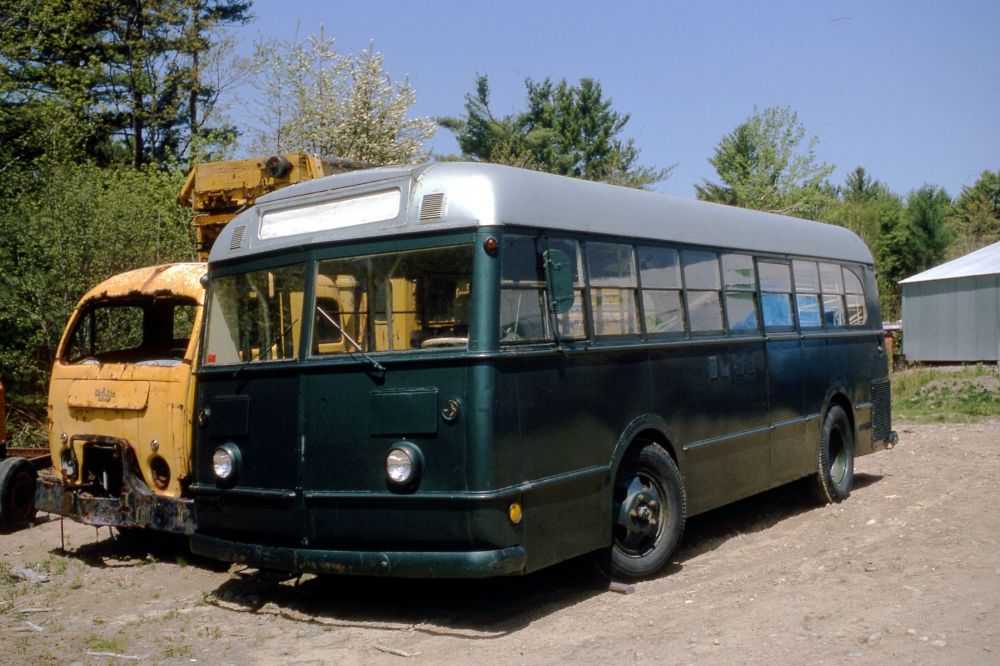
Norman Down
- Builder
- Ford
- Description
- small rear engine bus
- Secondary Use
- camper
- Type
- Motor Buses
- Year
- 1944
- Acquired by the Museum
- 1992
- Note
- No. 12 is stored outside the Central carbarn. The body, frame and underfloor are in excellent condition. The body has rust damage, and seats are not installed. Seashore plans to move No. 12 to indoor storage in the Fairview carbarn.
Houlton Bus Company 12
From Houlton, Maine
History
Ford Motor Company built this Ford Transit Bus for Houlton Bus Company of Houlton, ME in 1946. The Ford Transit Bus was the only bus model that Ford produced. Ford produced approximately 14,700 Transit Buses between 1937 and 1947. Ford’s model originally had an engine in the front, but beginning in 1939, the bus had a V-8 Ford gasoline engine in the rear. Ford constructed the bus chassis which was then fitted with a body by Union City Body Company of Union City, Indiana. The Ford Transit Bus was inexpensive, lightweight and relatively small with a length of just 25’ 9” and 27 seats. Some operators considered the bus underpowered and replaced the engine, but this bus retained its Ford engine.
Houlton had almost no local bus service until 1942 when the Houlton Bus Company began operating. The company was originally owned by Frank Totman and Jerry Burns of Houlton. They later sold it to George Anzuoni of Revere, MA. Houlton Bus Company’s main service was to an Army Air Base. When the air base closed in 1944, it became Camp Houlton, a large prisoner of war camp and a continuing source of bus passengers. The POW camp closed in 1946. At its peak, Houlton Bus Company had a fleet of 12 buses. On February 26, 1946, it became a subsidiary of the Bangor & Aroostook Railroad, which also started local bus service in Presque Isle, Maine. Soon after, Penobscot Transportation Company acquired the Houlton bus fleet. Penobscot was a subsidiary of Bangor Hydro and operated the bus service in Bangor, Maine. Penobscot had a fleet of 24 Ford Transit buses, Nos. 200 – 244, even numbers, but it is unclear whether Penobscot used Seashore’s bus in transit service. In 1950, Penobscot Transportation became Bangor Transit, controlled by the H.E. Salzberg Company which owned short line railroads in the Eastern U.S. as well as Queens Transit and Steinway Transit in New York City.
Also, about 1950, the Gardner-Templeton Street Railway (GTSRy) purchased this bus, along with some other Ford and ACF buses from Bangor Transit. The GTSRy operated buses between its namesake cities in Massachusetts as well as other nearby towns after replacing trolley service in the 1920s. This bus became No. 28. (Its fleet numbers in Maine are unknown.)
In 1957, Wilson Bus Lines acquired the GTSRy. Wilson had been operating bus service in Fitchburg, MA as well as charter service. Wilson continued to provide service between Gardner and Templeton. At Wilson No. 28 had a dark green paint scheme which may have been first applied by the Bangor & Aroostook. No. 28’s retirement date is unknown, but it was probably replaced by General Motors diesel buses by 1958. About 1958, a private individual acquired No. 28. The owner used the bus as a camper. It was not operated after 1959 but was stored indoors in Templeton and was serviced regularly. Wilson Bus Lines has continued to operate charter buses based at the former GTSRy carbarn in Templeton.
About 1991, Peter Wilson, of Wilson Bus Lines, purchased No. 28. He sold No. 28 to the Seashore Trolley Museum in 1992. Seashore did some initial work on the bus, including painting the roof and repairing the destination sign box. The destination roll sign has three destinations:
LIMESTONE
FT. KENT
MADAWASKA
Seashore then stored the bus under a tarp. Seashore designated the bus as No. 12, apparently because Seashore had previously acquired Templeton Street Railway horsecar No. 12 which had operated in Gardner and Templeton.
Technical Information
- Seats: 27
- Engine: Ford model SMB
- Tires: 8.25 x 20
Weight and Dimensions
- Length: 25’ 9.00"
- Width: 96.00"
- Height: 9’ 1.00"
- Weight: 10600 lbs.
© 1998 - 2025 New England Electric Railway Historical Society. All Rights Reserved.